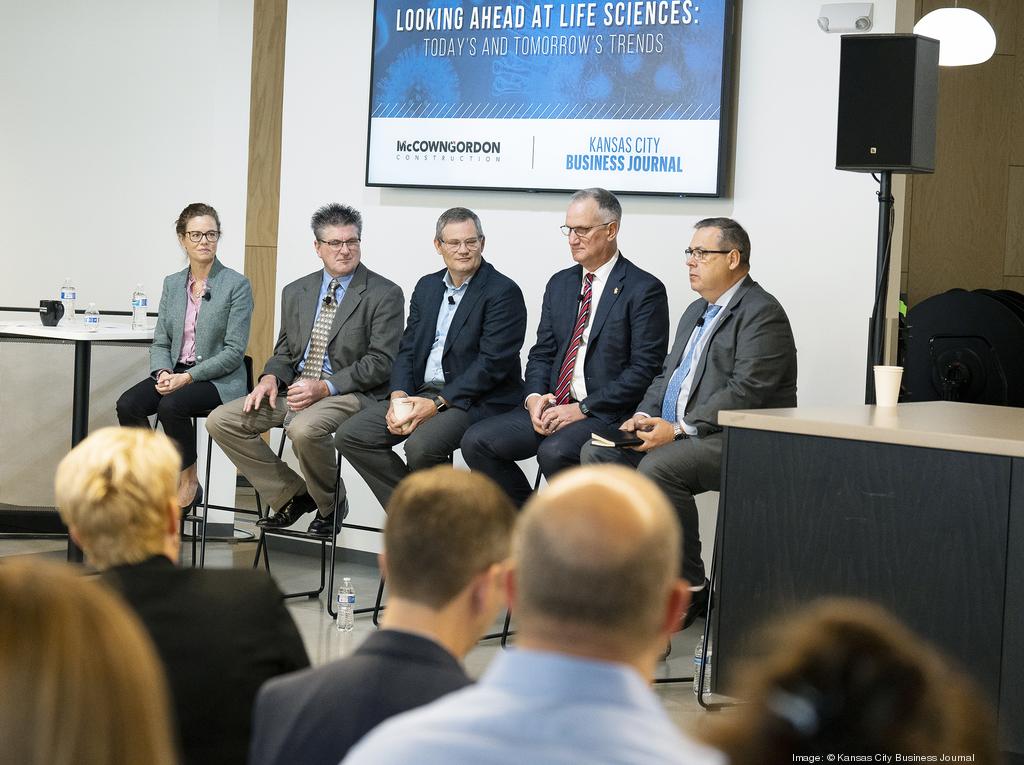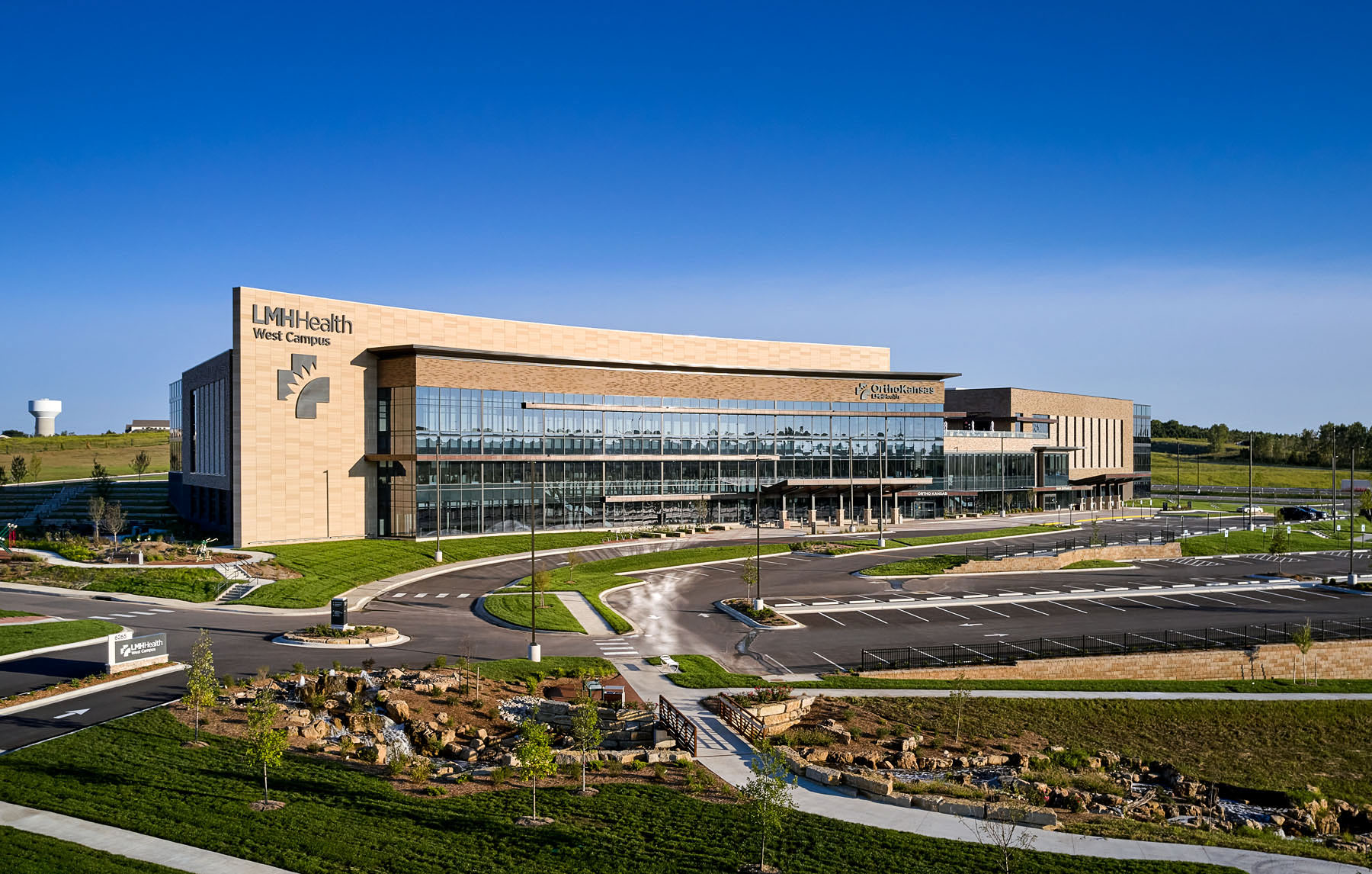Looking ahead at Life Sciences – Today’s and tomorrow’s trends

The Kansas City Business Journal recently brought together experts from local life sciences institutions to discuss their approaches to today’s issues and future trends. McCownGordon sponsored the events

Macro shifts during the past few years have brought life sciences to an inflection point, forcing an industry-wide resetting of priorities.
Concerns about sustainability, collaboration, and filling the employee pipeline have surged to the forefront, even as the institutions continue their dogged pursuit of innovation.
At a panel discussion sponsored by McCownGordon Construction, experts from local life sciences institutions discussed their approaches to today’s issues.
Promising advances
One of the fastest-changing areas in the industry today is biologics, said Laura Perin, CEO of laboratory equipment maker Labconco.
Biologics represent the cutting edge of biomedical research; they show incredible promise for effective treatment of illnesses and other conditions for which no treatments currently exist. As opposed to chemically synthesized drugs with known structures, biologics make use of natural — and harder to catalogue — substances.
The first FDA-approved biologic was about five years ago, Perin said; now there are thousands of patents pending or FDA applications for human biologics.
“That is incredible,” she said. “That is absolutely life changing. In the Kansas City region, we need to continue to think about ways in which we can invest in this biologics community.”
Robert Simari, executive vice chancellor for the University of Kansas Medical Center, said he was a postdoctoral fellow in gene therapy in the mid-1990s, but the field fell hard at the time. Yet now, 25 years later, there are long-term treatments for genetic diseases, with other treatments to come, and cancer care has been revolutionized.
“It’s really been interesting that the science went deep and solved a lot of the problems,” he said.
The science also has been going deep in terms of testing. Particularly since the COVID-19 pandemic began, labs have seen a shift toward testing — not just for an overarching disease, but for the molecules in different variants of a disease or in a cell.
“One of the things we spend a lot of time on is this increasing trend toward genomic testing,” said Myron Gunsalus, director of Kansas Health and Environmental Laboratories, which is part of the Kansas Department of Health and Environment.
Genomic testing checks for gene mutations in cancer to predict how it might act and potentially help pinpoint the best treatments.
From a manufacturing standpoint, many companies have been looking for reliable partners that can make their products for them, hoping to both reduce their manufacturing footprints and improve speed and agility, said Mark Frohardt, site director for TriRX Pharmaceutical Services. The company’s Shawnee facility manufactures and packages drug products for the human and animal health markets.
“That really shifts the landscape for both the big pharma companies and mid-sized pharma companies, as well as contract manufacturers,” he said. “That’s good for the area and the region.”
Complications for life sciences
Despite promising strides, behind-the-scenes issues have been troubling the industry.
For one, the pandemic displayed that the U.S. regulatory system needs an overhaul, said Ian Colrain, CEO of MRIGlobal, a nonprofit research institute that does contract scientific and engineering research for government and industry.
In the context of rapidly evolving threats, regulatory requirements for trials take too long, he said. Although emergency use authorizations helped during the pandemic, the issue needs a longer-term solution.
Along similar lines, costly clinical trial requirements have disrupted development of antibiotics, and Colrain worries about antibiotic resistance, which is when germs overcome the drugs designed to kill them. Almost every major pharmaceutical company has exited antibiotic development, and the Department of Defense is de-emphasizing it, in large part because the money doesn’t make sense. Getting an antibiotic through clinical trials poses high costs, and pharmaceutical companies can only recoup a fraction of that money through sales.
“We need a way of, again, decreasing the cost of particularly the clinical testing and coming up with better, faster, cheaper, smarter ways of ensuring the safety,” Colrain said. “We can’t compromise the safety, but there has to be a better way to do it than just the way we’ve been doing.”
Separately, Simari worries that, on a societal level, many of the exciting new medical solutions aren’t distributed equally. Supporting health care for everyone, given the distributed social determinants of health, poses an important challenge for society that won’t go away.
A looming labor gap
Perhaps the most pressing concern, however, is a crisis brewing on the life sciences horizon: lack of people.
The nation likely will be short 1.3 million nurses and 200,000 doctors by the end of this decade, Simari said. Even with an abundance of hospitals, beds will go empty if the staff isn’t there.
“This country will have a crisis on its hands if we are 1.3 million nurses short within the next eight years,” he said. “This is a trend that we’re all going to have to face.”
Likewise, Frohardt said, technical talent has become scarce. There’s a tremendous need for engineers, chemists, microbiologists — all those involved with science and development.
Automation also has shifted labor needs, Gunsalus said. Certain jobs that once required scientific knowledge now demand more technical knowledge. For instance, rather than needing to identify an organism through a microscope, an employee now must be able to troubleshoot the machine that identifies the organism.
And with new generations of employees come new demands: many in the current group want to be mobile and don’t plan to stay with one company for an entire career, Colrain said.
“There’s a dramatic increase in voluntary turnover, particularly in biotech,” he said.
So far in 2022, biotech turnover has been 18 percent — basically, one in eight people voluntarily jump ship for another company, Colrain said. In some markets, it’s much higher.
But the panelists aren’t sitting on their hands waiting for the crisis to hit.
Several tactics could help. For one, they’re interacting more with schools. That means trying to engage K-12 students throughout the community, regardless of background, as well as promoting trades and working with colleges and universities on curriculum.
“The decision to become a doctor is really made somewhere between third and seventh grade,” Simari said. “That decision is made for someone, depending upon whether they read in advance of their education, or whether they get into advanced math in seventh grade.”
Nursing and health professions may not be so dramatically restricted, but it’s vital to provide good K-12 education and to retain people in the community, he said.
Kansas Health and Environmental Laboratories has repurposed a mobile laboratory built during the COVID pandemic. It takes the lab to elementary, middle and high school students, letting them try procedures such as DNA extractions or diagnostic tests.
“We’ve got to engage younger, we’ve got to engage with culture, and we’ve got to offer people purpose,” Gunsalus said.
Also, professions such as nursing must broaden their recruiting pools to a more diverse population, Simari added.
Still, Colrain said he’s bullish about recruiting people to Kansas City. Biotech workers often can’t work remotely, and given today’s high interest rates, they may be drawn to a more affordable place that offers a good quality of life.
Companies need to emphasize their differentiators, Frohardt said.
“What is the hook? What is the intrigue that makes people stay?” he said. “Because if people don’t stay amidst growing rates of voluntary leavers, then that will cap and limit our ability to grow and even sustain.”
Specialized technologies not only empower people to do important work — they attract up-and-coming talent to Kansas City, and they bring potential advantages to patients, panelists said.
“Personnel clearly is critically important, but … technologies keep people staying in the community,” Simari said.
Likewise, partnerships among local institutions strengthen the life sciences community — and differentiate Kansas City from more cutthroat markets, Colrain said.
From a personnel standpoint, employers can stand out by truly paying attention to their people and by acknowledging their ideas and contributions.
“People want to be valued,” Frohardt said. “They want to be listened to, and they want to have some kind of purpose in what they’re doing. And those things, when it boils down to it, are pretty simple.”
A helpful step is honestly presenting company expectations and culture to potential hires.
“At Labconco, we can’t be all things to all people,” Perin said. “We are a manufacturing company. We work in person. We don’t work remote. We are very much a family-oriented business, but we’re not necessarily a family business. So if you want to work for Labconco, this is the way we operate. And that’s who we attract, and that’s who we retain.”
It’s not just a building
As life sciences organizations grapple with rapidly evolving needs and circumstances — including the tight labor market — their physical space requirements are evolving, too.
A scarcity of lab space seems to be turning around, but accessibility of capital has taken its place as a challenge for the industry, Colrain said. Some estimate that big pharma has more than $1 trillion in cash ready to spend, but they’re very selective. Meanwhile, high interest rates make borrowing difficult for emerging companies.
“We’re going to have to get to a new sort of equilibrium of how we develop new space, how we afford to develop new space, where the capital comes from,” Colrain said.
Companies would do well to consider retrofitting older buildings, especially those with crawl spaces under floors and in ceilings to make changes easier as lab needs evolve. Flexible building designs will make buildings more adaptable without requiring full renovations, panelists said.
Beyond technical needs, thoughtful buildings can serve valuable intangible purposes.
Labconco is expanding its Kansas City facility, and it plans to put the manufacturing facility around the corporate offices, Perin said.
“It will literally wrap around our offices because it is that important to us that our company operates as one, and we continue that culture of innovation and working together as a family,” she said.
Buildings, as well as displays about a company’s history, remind employees that they’re part of something bigger, Gunsalus said. McCownGordon is completing a new facility for KDHE with a display of Kansas health history.
And purposely engineering spaces, such as cafeterias, where employees will cross paths not only advances innovation — it builds culture and engagement, Colrain said.
“That type of space where you can have random collisions of people from different fields — where you can have knowledge leakage from one table to the next, even if it’s sort of a semi-overheard conversation, is critical to innovation,” he said.
Sustainability: From the periphery to the forefront
Even as organizations’ space needs evolve, a new concern promises to direct how they act on those needs into the future: sustainability.
Health care is the sixth-largest generator of carbon in society, and energy is critically important to the industry, Simari said.
“I think we’re moving to more sustainable models throughout,” he said. “It is a high-level item on our agendas — not just the cost, but doing the right thing.”
The Association of American Medical Colleges has taken sustainability as one of its pillars in strategic planning, which would have been an unexpected move a few years ago.
As an international company, Labconco has been paying close attention to the energy crisis overseas and recognizes it as a problem that has arrived here, as well.
General contractors such as McCownGordon have developed innovative ways to make costly scientific research buildings more affordable, and Labconco has been altering its products to meet those needs, too, Perin said. But as the company contemplates future growth and construction, the challenge is maintaining growth with sustainability in mind.
The reasoning is twofold — yes, sustainable practices help manage costs, but customers have been increasingly focused on sustainability practices.
“Our customers are coming to us now more than ever and saying, ‘Before I buy, I want to know your sustainability footprint,’” Perin said. “It used to be something they talked about … but now it’s, ‘No, we’re not going to buy it unless we fully understand your sustainability.’”
What complicates that, she said, is customers often have diverging definitions of sustainability.
Forging a broad base of allies
The pandemic strengthened connections among public, commercial and academic partners, and panelists hope to see those relationships continue.
“The more we can stay together, the stronger we are,” Gunsalus said. “I think that’s a key to the future.”
Some partnerships enable valuable expansions, such as those that would be impossible without public money. But relationships also can help avoid unnecessary construction, panelists said. When one organization hits its limits, it can rely on another — such as MRIGlobal helping the state perform testing during the pandemic, Gunsalus said.
Looking ahead, Kansas City must aggressively pursue funding, including from one of the largest funders — the National Institutes of Health, Perin said. Attracting federal funding requires investment in buildings, universities, K-12, manufacturing, and various individual life sciences players, which benefits everyone.
“We need to continue to build infrastructure, build the buildings, attract the talent,” Perin said. “It is the key to making this industry continue to grow — not just in Kansas City, but it’s going to impact all the surrounding cities.”
For that growth to really take off, though, word must spread about Kansas City’s advantages, Colrain said.
“Kansas City punches above its weight,” he said. “I think there will be a growing investment community in the Midwest that will look to funding and understand what they’ve got. But we need to just get better at letting the rest of the world know how good we are.”
One step, Simari said, is for local organizations to join large national and international organizations and put their data up against the best. If they post their strong performances, the employees and dollars will follow.
“I know that’s a little self-effacing, but I do believe in letting the data speak,” Simari said.
Watch Now





